
We welcome your opinions, comments and illustrations!
|
| Year | Events in Asakusa | National/International Events |
| 628 | Hamanari Hinokuma and his brother Takenari find a kannon statue in the Miyato River (present-day Sumida River) and Nakamoto Hajino builds the Senso-ji Temple to enshrine it. | Empress Suiko dies. |
| 645 | Shokai-Shonin stayed at Senso-ji temple to repair the main hall. The temple’s principle statue is closed to the public. | Taika no Kaishin (The Taika Reform). |
| 672 |
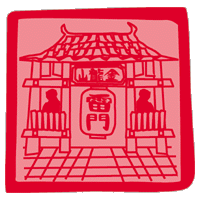
|
Jinshin War |
| 701 | The Taiho Code is enacted. | |
| 710 | The capital is moved to Heijo-kyo (Nara). | |
| 723 | Sanze Isshin Law (which allowed ownership of newly arable fields for three generations) is enacted. | |
| 743 | Konden Einen Shizai Law (which allowed the permanent ownership of newly arable fields) is enacted. | |
| 784 | The capital is moved to Nagaoka-kyo (Kyoto). | |
| 794 | The capital is moved to Heian-kyo (Kyoto). | |
| 857 | Jikaku-Daishi carves and dedicates a seikannon statue to be used as the Senso-ji's omaedachi image. | |
| 866 |

Masakado Taira |
Yoshifusa Fujiwara becomes regent. |
| 887 | Mototsune Fujiwara becomes chief advisor to the emperor. | |
| 894 | Dispatch of envoy to the Tang Dynasty in China is abolished. | |
| 935 | Masakado Taira Revolt (~ 940) | |
| 939 | Sumitomo Fujiwara Revolt(~ 941) | |
| 942 | Kinmasa Taira rebuilds Senso-ji's buildings and donates his rural land to the temple. | |
| 1016 |
 Kiyomori Taira |
Michinaga Fujiwara becomes regent. |
| 1086 | Leadership by the retired emperor begins. | |
| 1156 | Hogen War. | |
| 1159 | Heiji War. | |
| 1167 | Kiyomori Taira becomes Grand Minister of State. | |
| 1180 | Yoritomo Minamoto prays for victory over the Heike clan at Senso-ji. | |
| 1185 |
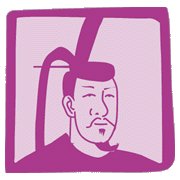 Yoritomo Minamoto |
Heike clan falls. Deployment of estate stewards and provincial constables begins. |
| 1192 | Yoritomo Minamoto becomes the Seii-Taishogun (Ruling Shogun). | |
| 1221 | Jokyu Revolt. | |
| 1232 | Goseibai Shikimoku (Court Regulations) established. | |
| 1297 | Shogunate issues the first Tokusei-rei (decree canceling debts). | |
| 1333 | Kamakura shogunate falls. | |
| 1334 | Kenmu no Shinsei (Kenmu restoration) begins. | |
| 1336 | Emperor Godaigo moves to Yoshino. | |
| 1338 | Takauji Ashikaga becomes the Seii-Taishogun (Ruling Shogun). | |
| 1352 | Ishihawa (Sumida River) War between Yoshioki & Yoshimune Nitta and Takauji Ashikaga. | |
| 1392 |  |
Southern and Northern Courts merge. |
| 1404 | Trade begins between Japan and the Ming Dynasty in China. | |
| 1428 | Shocho no Tsuchi Riot erupts. | |
| 1467 | Onin War (~ 1477) | |
| 1485 | Yamashiro no Kuni Riot erupts. | |
| 1488 | Kaga no Ikko Riot erupts. | |
| 1543 | Firearms introduced from Portugal. | |
| 1549 | Christianity introduced by Francis Xavier. Trade with Europe begins. |
|
| 1568 | Nobunaga Oda enters Kyoto. | |
| 1573 | Muromachi shogunate falls. | |
| 1582 | Honno-ji no Hen coup. National land survey begins. |
|
| 1588 | Sword law enacted (Allowing only members of the samurai class to possess swords). | |
| 1589 | Tsunayoshi Hojo, castellan of Odawara Castle, rebuilds Senso-ji. | |
| 1590 | Ieyasu Tokugawa designates Senso-ji as his official prayer hall and Zojo-ji as his family temple. | Hideyoshi Toyotomi completes national reunification. |
| 1592 |
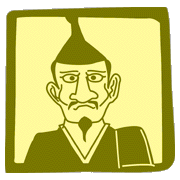 Ieyasu Tokugawa |
Military dispatched to Korea (~ 1597). |
| 1600 | Sekigahara War erupts. | |
| 1603 | Ieyasu Tokugawa becomes Seii-Taishogun (Ruling Shogun). | |
| 1615 | Hideyoshi Toyotomi falls. Buke Shohatto (laws regulating samurai houses) enacted. |
|
| 1618 | Toshogu shrine branch is built within the precincts of Senso-ji, and Zuishin-mon gate is completed. |
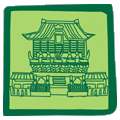
|
| 1631 | Senso-ji damaged in fire. | |
| 1636 | Asakusa-Mitsuke Gate is built. Japan strengthens its seclusion policy, increasingly isolating itself from the outside world. Kanei-Tsuho coin comes into use. | |
| 1637 | Shimabara War. | |
| 1639 | Japan closes its doors to the world completely. | |
| 1642 | Senso-ji damaged in fire. | |
| 1649 | Third Tokugawa Shogun Iemitsu builds Asakusa Shrine. Senso-ji is rebuilt. | Keian no Ofuregaki (proclamation of the Keian era) is issued. |
| 1654 | Senso-ji exhibits its Buddhist statue, the first time for a temple to do so in Edo (present-day Tokyo). | |
| 1657 | Large-scale fire breaks out in Edo (present-day Tokyo), forcing the Yoshiwara pleasure quarters in present-day Chuo Ward to be moved to Asakusa Nihon-Zutsumi. | Higashi Hongan-ji (Tokyo Hongan-ji) is moved to its current location. Jurohoshizaemon Mizuno kills Chobei Banzuiin. |
| 1672 | Emperor Reigen designates Senso-ji as a Chokugan-jo, an official place to perform prayer rituals for the imperial court. | |
| 1680 |
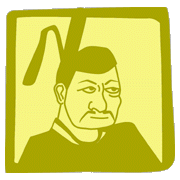 Hakuseki Arai |
Tsunayoshi Tokugawa becomes Seii Taishogun. |
| 1687 | Shorui Awaremi no Rei (law prohibiting cruelty to animals) is enacted (~ 1709). | |
| 1709 | Hakuseki Arai becomes key advisor to the government. | |
| 1716 | Yoshimune Tokugawa launches the Kyoho no Kaikaku (Kyoho reform). | |
| 1742 | Kuji Osadamegaki (legal precedence) is adopted. | |
| 1772 | Dempoin Temple is lost in a fire along with numerous ancient documents. | |
| 1774 | Agatsuma Bridge is completed. | Okitsugu Tanuma becomes senior advisor to the emperor. |
| 1783 |
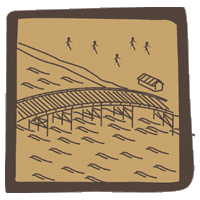
|
Tenmei no Daikikin (great famine of Tenmei) occurs. |
| 1787 | Sadanobu Matsudaira launches the Kansei no Kaikaku (Kansei Reform). | |
| 1825 | An order to repel foreign ships is issued. | |
| 1828 | Siebold Incident. | |
| 1836 | Tenpo no Daikikin (great famine of Tenpo) occurs. | |
| 1838 | Revolt led by Heihachiro Oshio. | |
| 1841 | Tadakuni Mizuno launches Tenpo no Kaikaku (Tenpo Reform). | |
| 1842 | As part of the Tenpo reform, Nakamura-za theater is moved to 1-chome, Asakusa - Saruwaka-cho, and the Ichimura-za theater to 2-chome. | |
| 1852 |
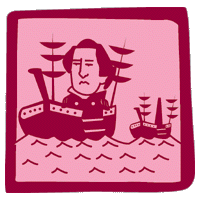
|
Perry arrives in Ryukyu (present-day Okinawa). |
| 1853 | Perry arrives in Uraga, Kanagawa Pref. | |
| 1854 | Japan-US Treaty of Amity and Peace is signed. | |
| 1858 | Japan-US Treaty of Amity and Trade is signed. Ansei no Taigoku (Ansei Purge)(~ 1859) takes place. | |
| 1863 | Anglo-Satsuma War erupts. | |
| 1864 | Shimonoseki War erupts. Shogunate attacks Choshu (present-day Yamaguchi). | |
| 1865 | Senso-ji's Kaminarimon Gate and neighboring buildings are lost in a fire. | |
| 1868 | Meiji Restoration. | |
| 1870 | Rickshaw transport begins in Nihonbashi, Tokyo. | |
| 1871 | Takanaka Teiunni donates the Genban Issai-kyo sutra to Senso-ji. Rinzo, a revolving sutra holder, is completed. | Abolition of clans and establishment of prefectures. |
| 1873 | Following a government order that each prefecture develop parks, the Senso-ji is designated Asakusa Park. | Enactment of a draft system and land tax reform law. |
| 1874 | Umaya Bridge is completed. | A written opinion calling for the establishment of a popularly elected parliamentary house is submitted. |
| 1875 | Karafuto-Chishima (Sakhalin-Kuril Islands) Exchange Treaty is signed between Japan and Russia. | |
| 1876 | Japan-Korea Amity Treaty is signed. | |
| 1877 | Seinan War erupts. | |
| 1878 | Shitaya Ward and Asakusa Ward were born. | Toshimichi Okubo is assassinated. |
| 1879 | Okinawa Prefecture is established. | |
| 1881 | Imperial decree issued for the establishment of the Diet. Liberal Party is formed. | |
| 1882 | Horse-drawn streetcars start running between Asakusa-Namiki-cho and Suka-cho, and between Ueno-Yamashita and Kaminarimon. | |
| 1884 | Asakusa Park is zoned into six areas. | Peerage Law is enacted. |
| 1885 | Cabinet system is introduced. | |
| 1887 | A mock Mt. Fuji is built in the Rokku Area of Asakusa Park. | |
| 1889 | Constitution of the Empire of Japan is adopted. | |
| 1890 | Ryounkaku (Junikai) opens. | First Imperial Assembly is called. Imperial Rescript of Education is issued. |
| 1894 | Extraterritoriality is abolished. Japan-Sino War (~ 1895). | |
| 1895 | Shimonoseki Treaty. Tripartite Intervention. | |
| 1899 | Aquarium opens in Yonku area. | |
| 1900 | Ashio Copper Mine pollution scandal. | |
| 1902 | Anglo-Japanese Alliance (~ 1922). | |
| 1903 | Denkikan theater opens in Rokku, the first such building to house a movie house in Japan. | |
| 1904 | Trams start running between Asakusabashi and Kaminarimon in February, and between Asakusa and Ueno in March. | Japanese-Russo War erupts. Yakumo Koizumi dies. |
| 1905 | Treaty of Portsmouth | |
| 1906 | Railway Nationalization Law is enacted. | |
| 1910 | Senso-ji Kyugosho (first aid center), present-day Senso-ji Hospital, opens. | Japan annexes Korea. |
| 1911 | Kinryukan open in Rokku. | French movie Zigoma becomes a big hit. Twelve persons, including Shusui Kotoku, are executed. |
| 1914 | Japan take part in World War I. | |
| 1917 | Heyday of Asakusa Opera. Kannon Theater opens next to Taishokan in Rokku. | Russian Revolution (March Revolution/November Revolution). |
| 1923 | Large earthquake hits the Kanto region on September 1st, causing great damage to the lowland areas in Asakusa and devastating the Rokku entertainment district. Ryounkaku building collapses. | Great Kanto Earthquake. Bungei Shunju and Akahata were first published. Takeo Arishima died. |
| 1925 | Popular election is held. Maintenance of Public Order is issued. |
|
| 1927 | The first subway in Asia starts running between Asakusa and Ueno in December. | Financial Crisis. Ryunosuke Akutagawa dies by suicide. Iwanami Bunko first published. |
| 1929 | Revue performance starts in the Denkikan theater. The Casino Follies starts performances featuring Enoken. Yasunari Kawabata begins writing Asakusa Kurenaidan for a newspaper. | Proletarian literature flourishes. Shimizu Tunnel opens. World plunges into the Great Depression. |
| 1931 | Manchurian Incident. | |
| 1932 | May 15th Incident. | |
| 1936 | February 26th Incident. | |
| 1937 | Asakusa International Theater opens in July. | Japanese-Sino War begins (~ 1945). Japan-China Incident. Awarding of the Order of Cultural Merit begins. |
| 1940 | Tripartite Military Alliance among Japan, Germany and Italy. | |
| 1941 | Neutrality Pact is signed between Japan and the Soviet Union. Pacific War (~ 1945). | |
| 1945 | An air raid in March completely destroys Asakusa. Everything is lost except Nitenmon and Dempoin. |
World War II ends on August 15th. United Nations is established. A new election law giving equal voting rights to men and women is issued. |
| 1946 | Japanese Constitution is adopted. Agrarian reform. | |
| 1947 | Asakusa Furansu-za opens in April. Asakusa Ward and Shitaya Ward are merged into Taito Ward. | Rokkuza opens in August. Compulsory educational system consisting of six-year elementary education and three-year secondary education is established. |
| 1951 | Asakusa Park is returned to Senso-ji. Work to fill in Hyotan-ike pond starts. | Peace treaty is signed between Japan led by prime minister Shigeru Yoshida and the US at the San Francisco Peace Conference. |
| 1958 | Following the enforcement of the Anti-Prostitution Law, teahouses in Yoshiwara close their doors. Asakusa Kannondo Hall is completed in October. | 10,000 yen banknote is issued. Tokyo Tower is completed. |
| 1960 | Kaminarimon Gate is rebuilt in May, 95 years after it was lost in a fire. | New security treaty is signed between Japan and US, which intensifies anti-security alliance protests. Demonstration organized by Zengakuren (All-Japan League of Student Unions) reaches the Diet building. Inajiro Asanuma is killed. Color TV broadcasting begin. |
| 1963 | Shochiku Theater closes. | Official decoration system for living persons is established. |
| 1964 | Okuyama Theater closed. Hozomon Gate is completed. | Tokyo Olympics is held. Tokaido Bullet Train begins operation. |
| 1965 | Basic treaty is signed between Japan and Korea. | |
| 1973 | Five-story pagoda is rebuilt. | Kim Dae Jung Abduction Incident. First Oil Crisis occurs, prompting Japanese people to rush to buy toilet paper and detergent. |
| 1976 | Chiyodakan, the oldest Denkikan theater in Japan, closes. | Lockheed Scandal surfaces. Quintuplets are born in Kagoshima. |
| 1977 | Yasuki-bushi performances end after a 40-year history in June. Asakusa Public Hall opens in October. | JAL flight hijacked by Japanese Red Army. Karaoke boom. Tracing one’s own roots becomes popular. |
| 1978 | Asakusa Kannon celebrates its 1,350th anniversary in March. | Narita International Airport opens. |
| 1980 | In January, Asakusa Public Hall hosts the first Asakusa Kabuki performance, the first kabuki performance in 22 years is held in Asakusa. | Defense Agency spy scandal. Sudden passing of Prime Minister Ohira. Singer Momoe Yamaguchi gives up her career to get married. |
| 1981 | In August, First Asakusa Samba Carnival is held, with dancers invited from Rio. Double-decker buses start running between Asakusa and Ueno. | Pope John Paul II makes his first visit to Japan. President Sadat of Egypt is assassinated. |
| 1982 | In April, SKD revue troupe gives its last performance ? the 51st Tokyo Odori ? at Asakusa International Theater, marking the end of the theater’s 50-year history. After the show, the theater is closed. | Princess Grace of Monaco dies in a car accident. |
| 1983 | Asakusa Rokkuza closes in March. Senso-ji’s Bentendo Hall is completed on March 28. | Former Filipino senator Aquino is assassinated. Keihaku-Tansho (light and compact) and Nekira/Neaka (gloomy/cheerful) become popular new words. |
| 1984 | A pedestrian bridge, Sakura Bridge, is completed across Sumida River. Asakusa View Hotel opens. | |
| 1985 | Nakamise-dori celebrates its centennial anniversary. Senso-ji celebrates the 30th anniversary since its Buddhist statue was returned to the temple (October 18 - November 4). |















